The real "problem" with NO3 is that none of us really know how much we have in the tank water. It is quite problematic to measure, even with lab. scale equipment. If you record 10ppm NO3 on your test kit, you know you have some nitrates, but you really don't know whether that is 10ppm, 20ppm or even 100ppm.
If you want to demonstrate this take a water sample, test it for NO3, and then add some salt (NaCl) or "Epsom Salts" (MgSO4.7H2O) to the water and test it again. You haven't added any more NO3, but you have added other anions (SO4-- & Cl-) and I would be surprised if you get the same result.
One thing that this forum has shown pretty clearly is that high levels of NO3 aren't toxic to fish, when they result from the addition of a fertiliser like KNO3, rather than being the "smoking gun" from high NH3 and NO2 levels.
Many people use EI with good results, but because I'm not interested in fast plant growth, or aquascaping, I use plant health as an index of the nutrient status of the tank.
If we can discount CO2 availability, plants need at least 10x more N and K than the other elements (including phosphorus (P)) and they are by far the most likely elements to be limiting for plant growth.
My method consists of monitoring the growth and colour of a floating plant, originally it was Duckweed (Lemna), hence the <"duckweed index">, but now I use Amazon Frogbit (Limnobium laevigatum) which is more tolerant of more acidic, nutrient poor water.
All the time the floating plants are a healthy green and in growth I don't add any nutrients, once growth slows, or the plants become very light green, I add KNO3. If they don't green up pretty rapidly I then feed them with a complete fertiliser.
So far the complete fertiliser has always done the job, and then it is back to monitoring "duckweed health".
I carry out regular small volume water changes (with rain-water), and that is it.
Yes I agree with you Darrel. It depends on each persons goals. But (there is always a but), isnt it possible to grow a bigger number of plants if we dont let nutrients bottom up? For example when I let nutrients get near 0ppm levels I normally get crypt melt, as well as for some other plants. This is what Tom Barr recommends with his low tech method. Do you get any melting? Do you use substrates?
Another thing I wanted to know is: Do plants grow faster at 30ppm Nitrates compared to say 5ppm, with the rest of parametres being non limitting?
Thanks in advance.


